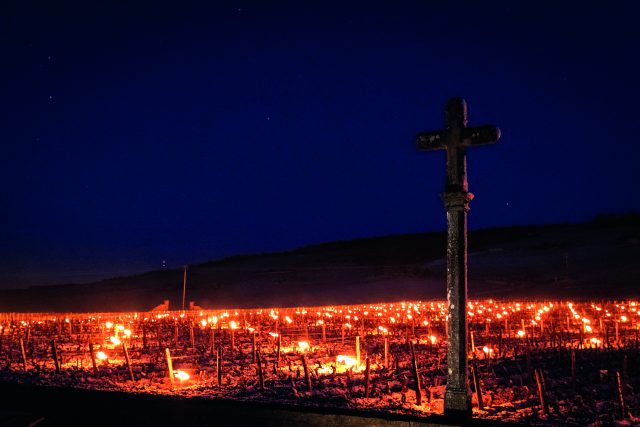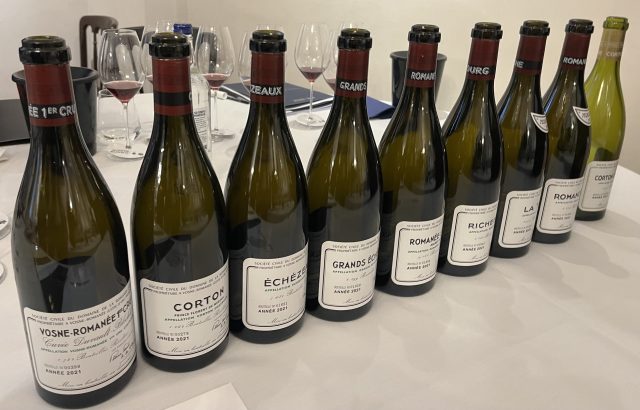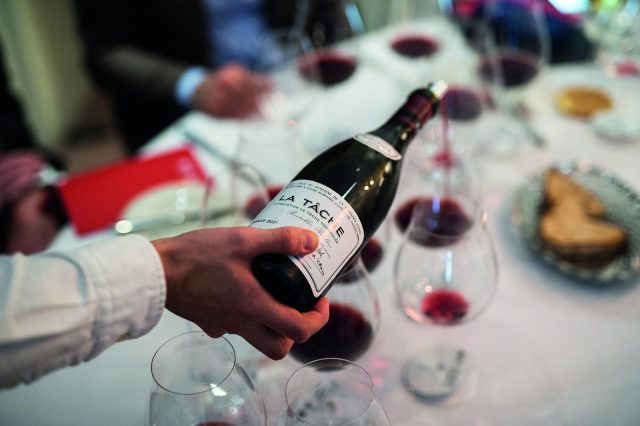Este sitio web utiliza cookies para que podamos ofrecerle la mejor experiencia de usuario posible. La información de las cookies se almacena en su navegador y realiza funciones como reconocerle cuando vuelve a nuestro sitio web y ayudar a nuestro equipo a comprender qué secciones del sitio web le resultan más interesantes y útiles.
Domaine de la Romanée-Conti 2021: elegancia ante la adversidad
La añada 2021 fue testigo de los estragos de las devastadoras heladas primaverales en Borgoña, pero ¿cómo resistieron los vinos de su finca más prestigiosa? Louis Thomas nos lo cuenta.

Los codirectores del Domaine, Perrine Fenale y Bertrand de Villaine, estuvieron presentes en las oficinas del comerciante Corney & Barrow para la presentación en primeur de sus vinos 2021 ante un grupo de profesionales del sector del vino.
El director gerente de Corney & Barrow, Adam Brett-Smith, reveló que la cata no era algo seguro: "Debatimos con el domaine sobre si hacer algo dado el patético tamaño de la añada, pero decidimos que debíamos hacerlo".
Tras un invierno suave, el golpe decisivo se produjo en las noches del 6, 7 y 8 de abril, cuando una repentina ola de frío hizo descender el mercurio hasta -8 °C en algunas partes de la finca. Las nevadas del 7 de abril, seguidas de otra helada la noche siguiente, acabaron con los brotes. Esta catástrofe puso en entredicho la creencia generalizada de que los viñedos situados a menor altitud son más vulnerables a las heladas (ya que el aire fresco y húmedo se asienta), ya que las zonas más altas, como La Tâche en Vosne-Romanée, se vieron más afectadas. Un verano más cálido, pero a menudo húmedo, no contribuyó a disipar los temores de un bajo rendimiento, sobre todo cuando los daños ya se habían producido.
Aunque "patético" es una palabra muy fuerte, las cifras son realmente desalentadoras. Las heladas costaron muy caras a los viñedos. La zona de Vosne perdió cerca de la mitad de su cosecha, y Corton y Montrachet perdieron la friolera del 90%. La vendimia en Corton, que tuvo lugar del 26 al 27 de septiembre, arrojó un rendimiento por hectárea de 5 hectolitros (24,6hl/ha en 2020), y la de La Tâche no fue mucho mejor, con 8,6hl/ha (29,7hl/ha en 2020). Lo bueno es que las condiciones meteorológicas antes de la vendimia fueron favorables.
Calidad sobre cantidad
Pero Brett-Smith sugirió que las inmensas pérdidas hacían aún más valioso lo que quedaba: "Los vinos nacidos de añadas difíciles a veces tienen una belleza directamente proporcional a la dificultad".
La noche anterior, Corney & Barrow había realizado una cata comparativa de los 2021 con los vinos de 2008, una añada que, según Brett-Smith, "hace que 2021 parezca fácil".
Fenale se mostró igualmente estoico, sugiriendo que no tiene sentido llorar por las uvas que podrían haber sido: "En lugar de sentir lástima por la falta de cantidad, nos sentimos bendecidos de que las vides hayan podido madurar su fruto".
Al final de la temporada de crecimiento, a finales de septiembre y principios de octubre, los niveles potenciales de alcohol estaban entre el 13,5% y el 14%.
En la bodega, tras una cuidadosa selección de las uvas, el maître de chai Alexandre Bernier vinificó los racimos enteros, aunque con un periodo de maceración más corto para reducir el riesgo de extraer sabores "verdes" o vegetales.
Debido a la naturaleza relativamente delicada de los vinos, se optó por un período más corto de maduración en barrica para no impartir demasiado carácter de roble. A continuación, los vinos pasaron una temporada en acero antes del embotellado, que tuvo lugar entre diciembre de 2022 y abril de 2023.

"Cuando probé por primera vez el Vosne-Romanée 1er Cru Cuvée Duvault-Blochet, pensé que era demasiado bueno", opinó Brett-Smith, destacando su sorprendente concentración para un año tan fresco.
A continuación, el Corton, o lo poco que había, ofrecía un perfume de frutos rojos y, en opinión de De Villaine, "un toque de elegancia". De hecho, "elegancia" sería el calificativo clave para muchos de los vinos catados, consecuencia de un periodo vegetativo fresco y una maceración más corta.
Sobre el Échézaux, que fue la última parcela vendimiada (la vendimia terminó el 2 de octubre), Fenale dijo que lo que le faltaba de concentración lo compensaba con su "maravillosa estructura". Más estructurado aún era el Grands Échézaux, que, a pesar de su juventud, ofrecía taninos con un ligero agarre, pero que no eran en absoluto verdes. El viñedo Grands Échézaux también obtuvo los rendimientos más impresionantes de 2021, con 21,6 hl/ha.
El Romanée-St-Vivant es, en palabras de De Villaine, un "puño en guante de terciopelo... muy tradicional, con mucha energía y fuerza".
A continuación, se hizo hincapié en la "elegancia" del Richebourg, cuya cata marcó la primera vez en varios años que se degustaba después del Romanée-St-Vivant, a pesar de la potencia de este último.
Incluso se sugirió que con vinos de esta calidad, pueden trascender los problemas de la temporada de cultivo.
"Romanée-Conti es otro universo", según De Villaine. "Incluso en una añada difícil, todo es siempre picante y elegante. No es un alarde explosivo, pero se siente sólido en boca: tiene mucho material".
Una opinión similar se expresó sobre el Corton-Charlemagne, la tercera añada del domaine de este vino blanco vinificado a partir de las parcelas En Charlemagne y Le Charlemagne. Las uvas Chardonnay que sobrevivieron a las heladas (el rendimiento para 2021 fue de 4,8 hl/ha, menos de una décima parte que en 2020) crearon finalmente un vino que la nota de cata de Brett-Smith resumió como "a la vez sabroso y cremoso".
De los nueve vinos catados, el que pareció ser unánimemente el favorito de los asistentes ese día fue La Tâche (1.470 libras por una botella en depósito), que Fenale describió como destacado por su "serenidad". Tal vez, como sugirió Brett-Smith, su atractivo estuviera directamente relacionado con su difícil temporada de cultivo.

De Villaine observó que, a pesar de su juventud, La Tâche ya se mostraba especialmente bien: "Ahora es perfectamente magnífico. Si se toma un La Tâche de 2019, por ejemplo, es necesario guardarlo durante algún tiempo, ya que es fuerte y potente. Este vino [2021] es más elegante".
Las guías de fechas de consumo de Corney & Barrow sugieren que La Tâche estará en su mejor momento entre 2029 y 2040.
"Pensábamos que los 2019 serían muy fáciles de beber jóvenes; nos sorprendió", añadió Fenale, antes de aclarar que el domaine no "pretende" crear vinos para beber pronto: "Tienen su propia vida".
Preguntado por el potencial de envejecimiento, Fenale bromeó: "¡No hay mucho vino que esperar!".
De Villaine sugirió que elaborar vinos para beber jóvenes "no era el espíritu del domaine", y comentó: "Lo importante es que vinos como el Échézaux, por ejemplo, puedan beberse jóvenes, pero sigan teniendo capacidad de recorrido en el futuro".
Las estimaciones de Corney & Barrow para el periodo de consumo se extienden en general hasta la década de 2030, y se prevé que el Montrachet (del que sólo se elaboraron cuatro barricas de la cosecha de 2021) siga siendo excelente hasta bien entrada la década de 2040.
Sin duda, la escasez añade valor, aunque el precio del vino no es proporcional a su escasez. El folleto de Corney & Barrow de la añada 2020, significativamente más abundante, muestra la diferencia de precios que alcanzan las botellas de 2021, comparativamente más escasas. Por ejemplo, en aquel momento, una botella en depósito de Romanée-Conti 2020 costaba 3.870 libras; para la añada 2021, 4.250 libras. Del mismo modo, en el extremo comparativamente más bajo con Corton, una caja de tres botellas de 2020 en bonos fue de 1.185 £, mientras que para el 2021 es de 1.305 £ - aumentos notables, si no monumental.
Sin duda será interesante ver cómo el lanzamiento de la añada 2021 impactará en la posición de Domaine de la Romanée-Conti en el Liv-ex Power 100 - en 2023 la finca cayó al puesto 67, habiendo sido segunda en 2019.
Recepción helada
Aunque las velas utilizadas para calentar las uvas en las noches heladas en toda Borgoña ofrecían bellas imágenes, esta técnica tradicional contra la escarcha conlleva una serie de desventajas, especialmente debido a la mano de obra necesaria para mantenerlas encendidas durante la noche, y su eficacia es cuestionable. Para el Domaine de la Romanée-Conti, el uso de velas en 2021 era la "primera vez" que se tomaba una decisión de este tipo, según De Villaine.
Sin embargo, también podría haber sido la última vez.
"Tenemos algunos almacenes de velas que nunca utilizaremos", reveló Fenale.
El Domaine de la Romanée-Conti también invirtió anteriormente en un molino de viento para ventilar las viñas y reducir así, en teoría, el riesgo de heladas. Sin embargo, se consideró "poco práctico" por las molestias acústicas que causaba a los vecinos y porque, según De Villaine, sin calefactores añadidos (y el gasto extra de energía que conllevan), se limitaría a agitar el aire frío por el viñedo, lo que podría agravar el problema.
También se sugirió que intentar prevenir estos riesgos climáticos era antitético con la filosofía y la identidad del Domaine de la Romanée-Conti.
"¿Vamos a seguir haciendo Romanée-Conti dentro de 10 años si tenemos cables de calefacción por las viñas?", exclamó De Villaine, "¿o vamos a saltarnos añadas?". La respuesta a ambas sugerencias es un rotundo "no". Anteriormente, había sugerido que 2021 fue un año anómalo y que, en general, una temporada de crecimiento más cálida debido al cambio climático ha hecho que las añadas sean "más fáciles" en los últimos años.
Fenale argumentó que el Domaine de la Romanée-Conti, que se adhiere a las prácticas de viticultura ecológica, tiene que respetar las cartas que le tocan en cada temporada de cultivo: "Nuestra decisión es librar las batallas cuando lleguemos a ellas, pero no intentar ganar la guerra".
De Villaine se hizo eco de este sentimiento.
"No queremos borrar la influencia de la naturaleza, ni del terruño que tenemos", afirma. "Tenemos una producción pequeña, no tenemos derecho a modificar lo que ocurre. Hagas lo que hagas, la naturaleza siempre gana".

